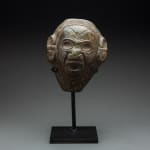Taino Stone Head, 1200 CE - 1500 CE
Stone
18.4 x 15.2 cm
7 1/4 x 6 in
7 1/4 x 6 in
BF.043
Further images
Carved from a dark, green/brown flecked stone, the form of this Taino artefact is highly unusual amongst surviving pieces. Although stylised anthropomorphic faces with skeletal features are common, they usually...
Carved from a dark, green/brown flecked stone, the form of this Taino artefact is highly unusual amongst surviving pieces. Although stylised anthropomorphic faces with skeletal features are common, they usually appear on full-length zemi sculptures or the distinctive three-cornered stones (trigonolitos). This sculpture is also too large and heavy to have been used as an amulet. The base is flat so it was intended to stand vertically whereas many of the three-pointers have the face directed up towards the sky. Whilst the mystery of its function may never be resolved, the quality and expression of the carving continue to impress. This must have been a high status item that belonged to one of the Taino chieftains (caciques). Controlling the use of expensive materials and the commissioning of ritual sculptures was one of the ways that these rulers maintained their political and religious authority. The sculptor was clearly inspired by his raw material which has been manipulated to great effect. Not only is the surface highly polished, but the greener areas of the stone have been used to highlight the face, whilst the darker brown areas were reserved for the reverse. The back is flat and unadorned except for several irregular indentations, possibly the result of handling and usage by its original owners.
The face itself has two deeply carved circular orbits and an oval shaped mouth. The nose is snout-like and it is not unusual in Taino art to find human and animal features combined in a single image. This is partly explained by their mythological traditions. Animals were venerated as some of the Taino’s earliest ancestors and it was also thought that human souls could return to earth in animal form. A band of incised geometric motifs encircles the face, interrupted only by the large, highly stylised ears. Scarifications marks or tattoos adorn the face, between the eyes and on the forehead. These undoubtedly had a ritual or cosmological significance that is difficult to reconstruct today. The identity of the face is uncertain. Although we know a significant amount about their pantheon of deities (zemis) and the importance of ancestor worship- it is rare that we can match the descriptions with surviving artefacts. The sculpture does however reveal the ingenuity and inventiveness with which Taino craftsman approached the task of fashioning religious art. In excellent condition, it would make a fascinating addition to any serious Pre-Columbian collection. (AM)
The face itself has two deeply carved circular orbits and an oval shaped mouth. The nose is snout-like and it is not unusual in Taino art to find human and animal features combined in a single image. This is partly explained by their mythological traditions. Animals were venerated as some of the Taino’s earliest ancestors and it was also thought that human souls could return to earth in animal form. A band of incised geometric motifs encircles the face, interrupted only by the large, highly stylised ears. Scarifications marks or tattoos adorn the face, between the eyes and on the forehead. These undoubtedly had a ritual or cosmological significance that is difficult to reconstruct today. The identity of the face is uncertain. Although we know a significant amount about their pantheon of deities (zemis) and the importance of ancestor worship- it is rare that we can match the descriptions with surviving artefacts. The sculpture does however reveal the ingenuity and inventiveness with which Taino craftsman approached the task of fashioning religious art. In excellent condition, it would make a fascinating addition to any serious Pre-Columbian collection. (AM)







